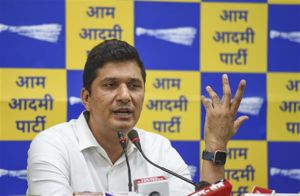
Desperate times, desperate measures: Over the past few months, among other steps to boost economy, India has serenaded investors, put mega PSUs on sale, cut corporate taxes and simplified the labour code. However, the crisis only seems to be deepening file photos: Agencies
Sandeep Dikshit in New Delhi
BJP MP Nishikanth Dubey was partly right when he said that the gross domestic product (GDP) cannot be the Bible or the Ramayana. The concept of GDP, propounded by Simon Kuznets, was never to measure the other important parameters of human existence such as well-being and happiness. It began as a domestic political tool, first used by US President Theodore Roosevelt to convince the public that their economic status wasn’t being affected by the US entering World War II.
The US domination of the Bretton Woods Institutions — the World Bank and the International Monetary Fund — led to the concept of GDP becoming the global parameter of economic activity. It never was an accurate indicator of economic wellbeing, which explains the poor human development indicators in states that have done well in economic statistics.
But the GDP cannot be easily wished away as it has become closely linked with politics of the day. Despite trying to meet the identity-linked aspirations of a large section of the population with the Ram Temple, converting J&K into a UT and promising a Citizenship Bill that excludes Muslims, the BJP will find it difficult to repeat its electoral success unless the government is able to meet the demand side shortfalls in GDP. Investment, private consumption, government spending and net exports, all these have combined to sink its growth rate to 4.5 per cent for the second quarter of the current fiscal, basically between July and September this year. Had it not been for the government spending and subsidies, the GDP growth rate would have been rock bottom.
Economists suspect that the July-September quarter may have been the lowest for the past 15 years. The GDP meter has been down for five quarters and may now be translating into a deep slowdown, at least by India’s standards of GDP growth rate for the last two decades because there are few countries of India’s size that clock growth rates of five to eight per cent and yet encounter such political turbulence and general public unease at the state of affairs.
A superficial dissection would reveal that the problem lies in the low rate of growth in consumption which is now barely matching the growth in population and an equally slow rise in investment — gross fixed capital investment, one per cent between April and September this year, and not very salutary earlier as well. Both have had a knock-on effect on manufacturing, which has shrunk in the last few months. Another key GDP component is net exports. These have been in the red and are facing more turbulence as world economy this year may grow only by 2.5 to 3 per cent.
The reasons for low consumer demand (consumption) are the lay-offs due to contraction in some manufacturing sectors and the crisis in agrarian sector that has squeezed disposable income. And in low private consumption, it is the private fixed capital expenditure (PFCE) of households, constituting over half of the GDP growth, that has been slowing down.
In the months since it became apparent that the economy was in trouble, the government has taken most of the steps any dispensation would take — serenaded investors, put mega PSUs on sale to raise income, effected the largest-ever cut in corporate taxes, deepened the bond market, improved the Insolvency and Bankruptcy Code, merged PSU banks and simplified the labour code.
Yet, something seems amiss. The finger has been put on the problem from two quarters. Former Prime Minister Manmohan Singh has spoken of a “toxic climate of deep mistrust and pervasive fear” that has led to the fall in numbers. In other words, the tangible and the intangible parameters of happiness and well-being because “our social fabric of trust, confidence is now torn and ruptured.” In other words, the strong-arm methods to settle problems may be unnerving people — from the man on the street to the corporate executive.
The second view, held mainly by left-leaning economists, is that the Indian growth story since 1991 has now reached its limits. India’s participation in knowledge-based economy has stagnated and half a million students from affluent families, who would have driven consumption, fly abroad every year. It is time to shift attention to meeting the demands of the larger and less well-off section of the population. They also worry about the inadequate attention from successive governments to some vital parameters of human development index, especially knowledge, the pedestal for growth, whether economic or individual. The problem and the potential lie in the people rather than the tools of economic management. India’s rank of 130 on the UNDP’s HDI index sits uneasily with its steady improvement in the World Bank’s ease of doing business. Even if the growth rate begins galloping in the later years of the Modi government, the edifice will remain at risk.
Broad parameters of GDP
- Private consumption: Consumer durables, semi-durables, non-durables and services
- Investment: Government and private investment
- Government spending: Purchase of intermediate goods, wages and salaries paid by government
- Net Exports: Exports minus imports



























